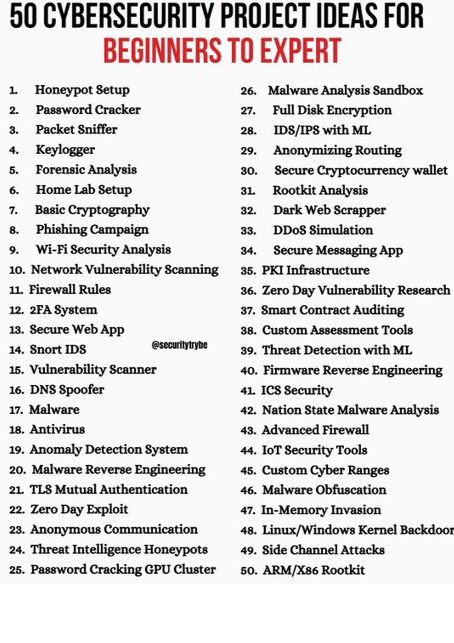Cybersecurity is a rapidly growing field, with the global cybersecurity market projected to reach $500 billion by 2030 (Source: Fortune Business Insights). This growth creates numerous opportunities for learners and professionals to develop their skills through hands-on projects.
Whether you’re a beginner looking to understand the basics or an expert seeking advanced challenges, there’s always a new area to explore, such as AI-driven security, zero-trust architectures, and quantum cryptography.
Here, we’ve compiled 50 cybersecurity project ideas that can help you gain practical experience and enhance your problem-solving skills.
Beginner-Level Cybersecurity Projects
If you’re new to cybersecurity, these projects will help you build foundational skills in networking, cryptography, and ethical hacking.
- Honeypot Setup – Deploy a honeypot to lure and analyze cyber threats.
- Password Cracker – Create a tool that can test password strength using brute-force or dictionary attacks.
- Packet Sniffer – Develop a simple tool to monitor and analyze network traffic.
- Keylogger – Understand how keyloggers work by building a basic one for educational purposes.
- Forensic Analysis – Conduct digital forensics on a sample system to investigate a cyber incident.
- Home Lab Setup – Set up a virtual cybersecurity lab for testing and learning.
- Basic Cryptography – Implement encryption and decryption techniques for securing data.
- Phishing Campaign – Simulate a phishing attack to understand how social engineering works.
- Wi-Fi Security Analysis – Analyze and secure wireless networks against potential threats.
- Network Vulnerability Scanning – Use tools like Nmap or Nessus to identify vulnerabilities.

Intermediate-Level Cybersecurity Projects
For those with some experience, these projects will introduce advanced security concepts and penetration testing techniques.
- Firewall Rules – Configure firewalls to protect networks from unauthorized access.
- 2FA System – Implement two-factor authentication for secure login systems.
- Secure Web App – Develop a web application with robust security measures.
- Snort IDS – Set up and configure Snort for intrusion detection.
- Vulnerability Scanner – Build a tool that detects security flaws in software or networks.
- DNS Spoofer – Simulate DNS attacks to understand and prevent DNS hijacking.
- Malware Analysis – Examine malware behavior using sandbox environments.
- Antivirus – Develop a simple antivirus scanner to detect malicious files.
- Anomaly Detection System – Create a system that detects unusual patterns in network traffic.
- Malware Reverse Engineering – Analyze malicious software to understand its behaviour and impact. (Reference: NIST Malware Analytics)
Advanced-Level Cybersecurity Projects
For cybersecurity enthusiasts looking to push their limits, these projects involve sophisticated attack simulations, advanced encryption, and malware development.
- TLS Mutual Authentication – Implement mutual TLS for secure communication between clients and servers.
- Zero Day Exploit – Research and simulate zero-day vulnerabilities.
- Anonymous Communication – Build a secure communication system that ensures anonymity.
- Threat Intelligence Honeypots – Design honeypots that collect real-world cyber threat data.
- Password Cracking GPU Cluster – Use GPU acceleration to crack passwords efficiently.
- Malware Analysis Sandbox – Create an isolated environment for analyzing malware behaviour.
- Full Disk Encryption – Implement encryption solutions for securing entire disks.
- IDS/IPS with ML – Develop an intrusion detection/prevention system powered by machine learning.
- Anonymizing Routing – Implement Tor-like routing for private communication.
- Secure Cryptocurrency Wallet – Design a secure cryptocurrency wallet with multi-factor authentication.
- Rootkit Analysis – Study and analyze rootkits to understand how they evade detection.
- Dark Web Scraper – Build a tool to scrape and analyze content from the dark web.
- DDoS Simulation – Simulate and analyze distributed denial-of-service attacks.
- Secure Messaging App – Develop an end-to-end encrypted messaging application.
- PKI Infrastructure – Implement Public Key Infrastructure for secure communications.
- Zero Day Vulnerability Research – Identify and analyze unknown vulnerabilities in software.
- Smart Contract Auditing – Review and secure blockchain-based smart contracts.
- Custom Assessment Tools – Build tools to evaluate the security posture of systems.
- Threat Detection with ML – Use machine learning to identify and prevent cyber threats.
- Firmware Reverse Engineering – Analyze and reverse-engineer firmware for security analysis.
- ICS Security – Secure industrial control systems from cyber threats.
- Nation-State Malware Analysis – Investigate and study nation-state-sponsored malware campaigns.
- Advanced Firewall – Develop a firewall with custom rule sets and detection mechanisms.
- IoT Security Tools – Build security tools to protect Internet of Things (IoT) devices.
- Custom Cyber Ranges – Create a controlled environment for testing security scenarios.
- Malware Obfuscation – Design techniques to evade malware detection systems.
- In-Memory Invasion – Study memory-based attack techniques and their countermeasures.
- Linux/Windows Kernel Backdoor – Analyze kernel-level backdoors and security implications.
- Side Channel Attacks – Investigate and demonstrate attacks that exploit physical hardware vulnerabilities.
- ARM/X86 Rootkit – Develop and study rootkits targeting ARM and X86 architectures.
Final Thoughts
Cybersecurity is an ever-evolving field that requires continuous learning and hands-on experience. According to a 2023 Cybersecurity Ventures report, there is an estimated global shortage of 3.5 million cybersecurity professionals, making skill development more critical than ever.
Whether you’re just starting or are an experienced security researcher, these projects will help you develop the skills needed to tackle real-world cyber threats. Start with beginner projects, move to intermediate challenges, and finally, take on advanced topics to become a cybersecurity expert!
Are you working on a cybersecurity project? Share your experience in the comments below! What challenges have you faced, and what tools have you found most useful?









 Evan John
Evan John